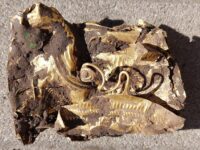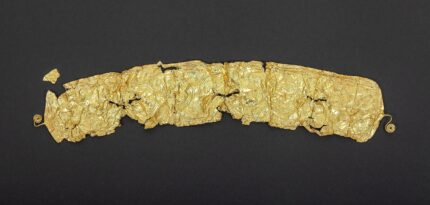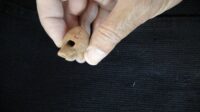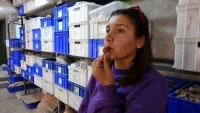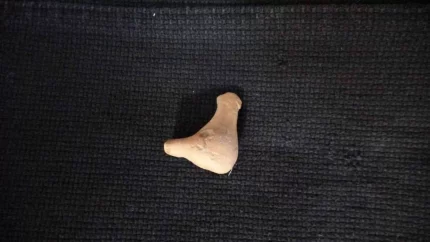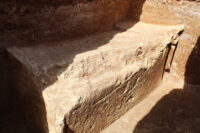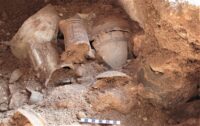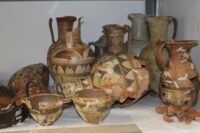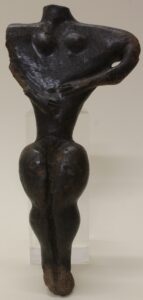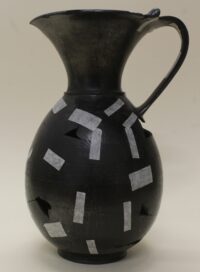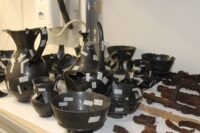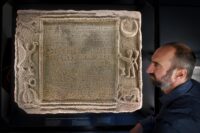 One of the longest inscriptions from Roman Britain with an exceedingly rare mention of an emperor whose name was erased after his assassination has gone on display for the first time since its discovery in 1960. The 600-pound sandstone slab was discovered near the Yorkshire village of Bainbridge, known as Virosidum in the Roman era, where a Roman Fort was built in the late 1st and early 2nd century A.D. It had once been part of the wall of a 3rd century barracks, but was reused in the 4th century as a paver for a road leading out from the east gate of the fort. Face-down, thankfully, which helped preserve the inscription in excellent condition.
One of the longest inscriptions from Roman Britain with an exceedingly rare mention of an emperor whose name was erased after his assassination has gone on display for the first time since its discovery in 1960. The 600-pound sandstone slab was discovered near the Yorkshire village of Bainbridge, known as Virosidum in the Roman era, where a Roman Fort was built in the late 1st and early 2nd century A.D. It had once been part of the wall of a 3rd century barracks, but was reused in the 4th century as a paver for a road leading out from the east gate of the fort. Face-down, thankfully, which helped preserve the inscription in excellent condition.
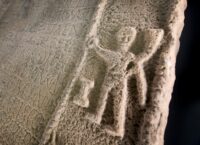 The large, heavy stone is intact, engraved with a 12-line inscription in Latin. Symbols are carved down the left and right sides. On the left from top to bottom are first the astrological symbol Capricorn, then Victory standing on a globe holding a wreath and lastly an eagle standing on a thunderbolt with a wreath in its beak. On the right are a crescent moon, a genius (guardian spirit) holding a horn of plenty under his left arm and a patera (libation bowl) in his right hand, poised to pour libation onto an altar at his feet, and lastly a horned animal believed to be a bull.
The large, heavy stone is intact, engraved with a 12-line inscription in Latin. Symbols are carved down the left and right sides. On the left from top to bottom are first the astrological symbol Capricorn, then Victory standing on a globe holding a wreath and lastly an eagle standing on a thunderbolt with a wreath in its beak. On the right are a crescent moon, a genius (guardian spirit) holding a horn of plenty under his left arm and a patera (libation bowl) in his right hand, poised to pour libation onto an altar at his feet, and lastly a horned animal believed to be a bull.
The inscription is a dedication stone recording the construction of the new barracks. It reads:
For the Emperor Caesar Lucius Septimius
Severus Pius Pertinax Augustus, and for the
Emperor Caesar Marcus Aurelius Antoninus
Pius Felix Augustus, and for Publius Septimius Geta most no
ble Caesar, in the consulship
of Our Lords the Emperor Antoninus for the
second time and Geta Caesar; the
Sixth Cohort of Nervians which Lucius Vinicius
Pius, prefect of the said cohort, commands,
built [this] barrack-block, under the charge of
Gaius Valerius Pudens, senator of consular rank.
The Sixth Cohort of Nervii was an auxiliary unit of Belgian recruits. The titles of Septimius Severus and his son Caracalla date the inscription to 205 A.D. Severus’ younger son Geta gets two credits as well, which is highly notable because after Severus died in York in 211 A.D., Caracalla killed his little brother and ordered the damnatio memoriae, the complete elimination of Geta’s name and likeness from the public record. That order certainly reached Britain, and indeed it looks like someone tried to comply with the damnatio by erasing line 6, only that was the wrong line. Geta’s name is still out and proud on lines 5 and 8.
It is a unique survival of great significance to the archaeological record of Roman Britain in general and Yorkshire in particular. It is also extremely unwieldy. The Royal Engineers of the army regiment stationed at York had to be called in to raise it in 1960. They transported it to the University of Leeds where it was kept in the basement for 60+ years.
Dr Samuel Gartland, a professor at the University of Leeds’ School of Languages, Cultures and Societies, was behind the effort to give this artifact its first public showing. The University didn’t have to enlist army specialists this time, but a specialized crane was required to hoist the stone to a new display that finally does it justice.
On display by its side is a much smaller, rougher inscribed slab that was found in the same 1960 excavation. It too was built into the wall of the barracks and it too had been flipped upside-down to pave the road. It’s a centurial stone, a marker bearing the name of the centurion who commanded the soldiers who built that section of wall. The one reads:
Of the Sixth Cohort of Nervii,
the centuria of Julius Martinus
Typically centurial stones were plastered over, unlike the imperial inscription which was intended to broadcast the strength of Roman force in the area. The fort had been abandoned in the second half of the 2nd century, so when the Nervii arrived, they had a lot of rebuilding to do. The dedication to the co-emperors was one way of broadcasting that the Romans were back in full force.
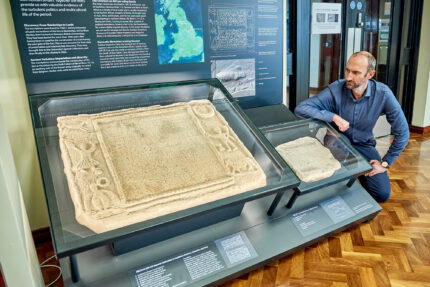
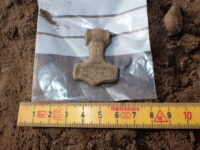 Archaeologists have discovered a lead Thor’s hammer amulet dating to the late 10th century in Ysby in southwestern Sweden’s Halland province. The hammer was unearthed at the site of future housing construction. Previous investigations at the site revealed archaeological remains from the Neolithic and Iron Age, but this is the first artifact from the Viking era discovered there. It’s also the first Thor’s hammer amulet found in Halland.
Archaeologists have discovered a lead Thor’s hammer amulet dating to the late 10th century in Ysby in southwestern Sweden’s Halland province. The hammer was unearthed at the site of future housing construction. Previous investigations at the site revealed archaeological remains from the Neolithic and Iron Age, but this is the first artifact from the Viking era discovered there. It’s also the first Thor’s hammer amulet found in Halland.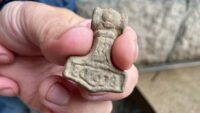 These were popular accessories in the Viking era, worn as apotropaic amulets, calling on the protective power of Thor to ward off evil. About a thousand of them have been found in Scandinavia, the UK, Russia and the Baltic countries. When this one was being worn, the Halland area was beginning to convert to Christianity. A pendant like this had religious significance beyond its purported warding powers, because it was unmistakable symbol of adherence to Form Sidr (meaning “the old way” ie, the traditional Nordic gods) as opposed to the new way of Christianity.
These were popular accessories in the Viking era, worn as apotropaic amulets, calling on the protective power of Thor to ward off evil. About a thousand of them have been found in Scandinavia, the UK, Russia and the Baltic countries. When this one was being worn, the Halland area was beginning to convert to Christianity. A pendant like this had religious significance beyond its purported warding powers, because it was unmistakable symbol of adherence to Form Sidr (meaning “the old way” ie, the traditional Nordic gods) as opposed to the new way of Christianity.